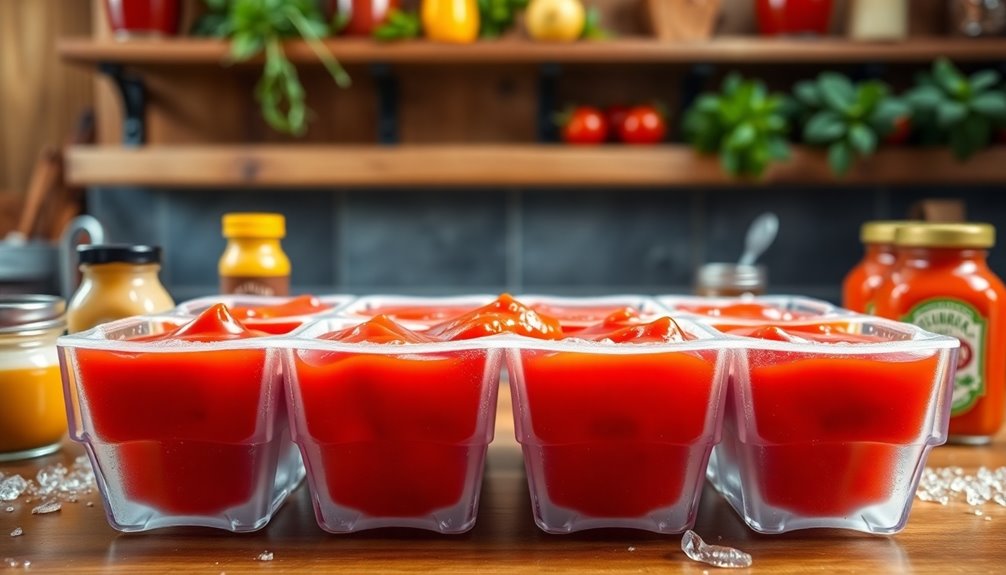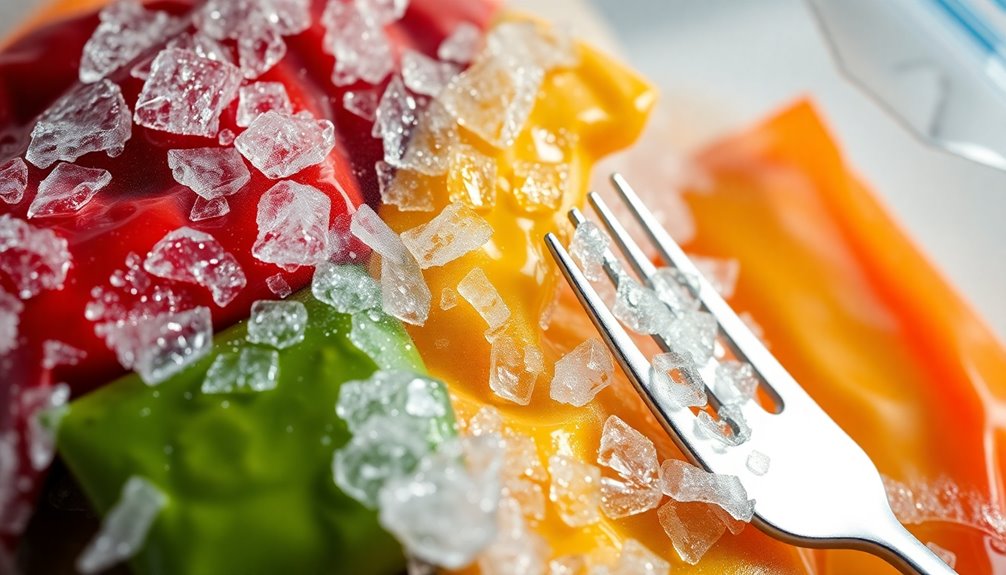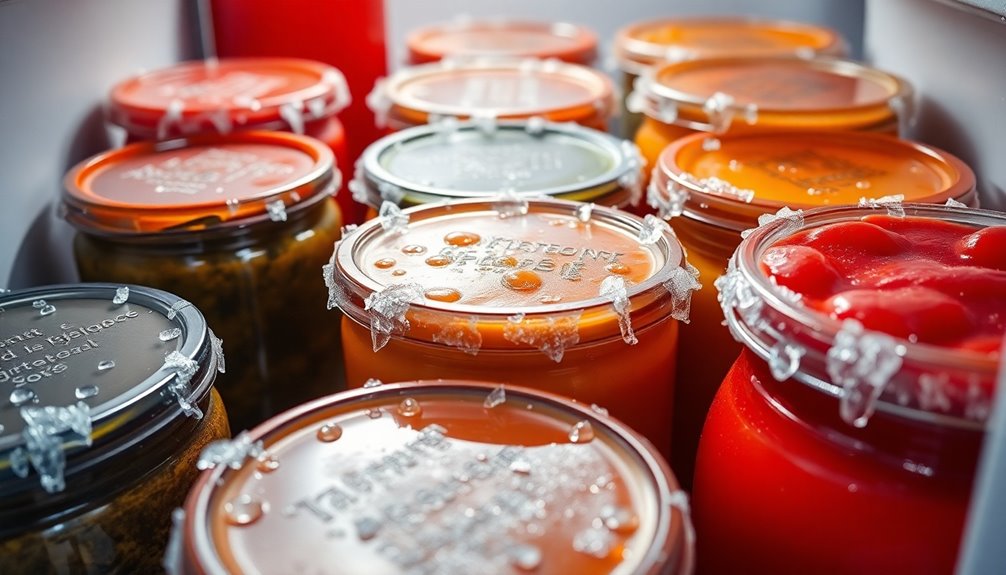Freezing ketchup and other condiments is a great way to extend their shelf life and prevent food waste while keeping their flavor intact. To freeze ketchup, use airtight containers or ice cube trays for easy portions. Remember to cool it before freezing and label your containers with dates. Ketchup can last about 3-4 months in the freezer, so use it within that time for the best taste. While you shouldn't freeze emulsified condiments like mayonnaise, many others like mustard and BBQ sauce work well. There's plenty more to discover about freezing condiments for maximum convenience!
Benefits of Freezing Condiments
When you freeze condiments like ketchup, you not only extend their shelf life but also make meal prep more efficient. By storing these condiments in the freezer, you can keep them fresh for up to six months without losing any flavor or quality. This means you can enjoy your favorite sauces without worrying about them spoiling in the fridge.
Freezing condiments helps reduce food waste, allowing you to save money by using what you've already bought. Instead of tossing out unused portions, you can freeze them in ice cube trays for easy portion control. This convenience means you can grab just the right amount for your meals without needing to thaw an entire bottle. Additionally, utilizing budget apps can foster better decision-making regarding financial management, ensuring you make the most of your grocery purchases without overspending. Many budgeting tools, like YNAB (You Need a Budget), can assist in tracking your grocery expenses effectively.
When you need a quick addition to your dish, having frozen condiments on hand makes cooking simpler. Whether you're preparing a burger or a pasta dish, you can easily incorporate these flavorful ingredients into your meal prep. Additionally, employing budgeting apps can help you track your grocery spending, ensuring you make the most of your purchases without overspending.
With frozen condiments, you benefit from both quality and convenience, ensuring that you always have delicious options ready to enhance your meals while minimizing waste.
Best Practices for Freezing
To make the most of freezing ketchup and condiments, you should start by properly portioning them. Using ice cube trays or snack-sized freezer bags works great for creating individual portions that make thawing a breeze later on.
Before you freeze anything, make sure the ketchup cools completely. This helps prevent condensation, which can lead to freezer burn and alter the texture of your sauces. Tracking expenses can also help you identify how much you spend on condiments, allowing for better budgeting in the future.
When it comes to containers, avoid using glass, as it can break in the freezer. Instead, opt for moisture-vapor resistant plastic bags or containers that freeze well. As you prepare your freezer bags, don't forget to label them with the date and contents. This step is essential for proper storage and tracking freshness; frozen ketchup can last about 3-4 months. Additionally, using expense management apps can help you keep track of your food expenses, ensuring you stay within budget while experimenting with freezing condiments. Moreover, automating your expense tracking with receipt scanning technology can save you time and enhance accuracy in managing your finances.
Keep in mind that while freezing ketchup might slightly change its texture, the flavor will remain intact, making it still suitable for your recipes.
How to Freeze Ketchup

Freezing ketchup is straightforward, and there are several methods you can use to make it easy to portion out later. You'll want to choose the right storage options and follow proper thawing techniques to maintain its flavor. Additionally, using AI-driven tools can help you discover the best storage solutions for condiments. Regularly tracking your savings and investments can also help in managing your budget for groceries. To make the most of your budget, consider utilizing expense tracking tools that simplify financial management and enhance your overall budgeting process. Let's explore how to freeze ketchup effectively and keep it fresh for your next meal.
Freezing Method Options
One effective way to preserve ketchup is by using airtight containers or resealable freezer bags. When using resealable bags, make certain to squeeze out excess air before sealing to prevent freezer burn.
If you prefer portioning, consider using ice cube trays. Simply fill the trays with ketchup, freeze until solid, and then transfer the cubes to a freezer bag for easy access later. This method allows you to use just the right amount in recipes without thawing the entire batch.
Remember to label containers with the date of freezing to keep track of freshness. It's best to use thawed ketchup within 3-4 months for peak flavor, as longer storage can lead to quality degradation.
Avoid refreezing ketchup after it has been thawed, as this can further affect its taste and texture.
Using these freezing method options guarantees you can enjoy your ketchup without waste while maintaining its quality. Whether you opt for airtight containers or convenient portion sizes, you'll have delicious ketchup at your fingertips whenever you need it!
Storage Recommendations
When it comes to storing ketchup, proper freezing techniques guarantee you maintain its quality and flavor. To freeze your ketchup, start by pouring it into ice cube trays for easy portioning. This method allows you to thaw only what you need for your meals, minimizing waste.
Once the ketchup is frozen into cubes, transfer them to a resealable freezer bag. Be sure to squeeze out excess air to prevent freezer burn, which can ruin the sauce's taste and texture.
Don't forget to label the bag with the date of freezing. Frozen ketchup can last up to six months, so keeping track of freshness is essential. If you've made homemade ketchup, take care; avoid freezing versions with high sugar content, as it may alter the texture upon thawing.
With these storage recommendations, you can enjoy your favorite condiment whenever you want without sacrificing quality. Just remember, when you're ready to use it, you can simply add the frozen cubes directly to your cooking dishes or place the desired amount in the refrigerator overnight to thaw.
Happy cooking!
Thawing Techniques
Thawing your ketchup properly is crucial to preserving its flavor and texture. The best way to thaw the sauce is by transferring it to the refrigerator overnight. This method guarantees that you maintain the ketchup's quality while following food safety rules.
If you need a quicker option, you can use cold water. Simply submerge the sealed container or freezer bag of frozen ketchup in a bowl of cold water, changing the water periodically to keep it cool. Avoid using hot water, as it can cause unsafe temperature rises and negatively affect the consistency of your ketchup.
Once thawed, remember to use the ketchup within 3-4 days if it's kept in the refrigerator. This keeps your condiments safe and flavorful.
If you've frozen ketchup in ice cube trays, you've got a handy trick up your sleeve. Just toss those cubes directly into your cooking dishes without needing to thaw them first. This method adds convenience and enhances your recipes without compromising on texture and flavor.
Freezing Other Common Condiments
Freezing a variety of common condiments can be a smart way to extend their shelf life and minimize waste. Condiments like ketchup, mustard, and BBQ sauce freeze effectively, maintaining their quality for up to six months. Additionally, using digital coupons can help you save on purchasing these condiments when you're restocking. Utilizing cashback programs can further enhance savings when replenishing your condiment supply.
To guarantee easy thawing and usage, it's best to freeze them in portion sizes using ice cube trays or resealable freezer bags. This way, you can grab just what you need without defrosting the entire batch.
However, be cautious with emulsified condiments like mayonnaise or aioli. They tend to separate and lose their desirable texture upon thawing, making them unsuitable for freezing.
When you freeze your condiments, remember to label each bag with the type and date of freezing. This helps you keep track of their freshness and guarantees you use them before their flavors diminish over time. Additionally, consider using sustainable packaging solutions to minimize waste when storing and freezing your condiments.
Thawing and Using Frozen Condiments

To enjoy your frozen condiments at their best, proper thawing techniques are essential. The most effective way is to place your frozen condiments in the refrigerator overnight. This method preserves the texture and flavor, ensuring you get peak quality when you use them. Additionally, using AI-driven recommendations can help you discover new condiments that pair well with your meals. Personalized suggestions can enhance your culinary experience by introducing you to flavors you may not have considered before.
If you need a quicker solution, you can submerge sealed, airtight bags of frozen condiments in cold water. Just make sure the bags stay airtight to prevent any water from entering.
Avoid using hot water for thawing, as it can lead to unsafe temperature increases and negatively affect the texture of the condiment. Once you've thawed your condiments, aim to use them within 3-4 days for the best taste. If your frozen condiments contain meat or dairy, remember to reheat them to at least 165°F before serving.
Interestingly, you can also add frozen condiments directly to cooking dishes without thawing them first. This technique can actually enhance flavors in soups, stews, and sauces, making your meals even more delicious. Additionally, using automated bill payment notifications can help you manage your finances while enjoying your culinary creations.
Storing Condiments for Longevity
To keep your condiments fresh for longer, it's essential to follow best freezing practices.
Use freezer-safe containers or resealable bags to prevent breakage and guarantee quality.
Portioning your condiments into smaller sizes not only makes thawing easier but also helps reduce waste.
Best Freezing Practices
Many people overlook the importance of proper freezing practices for condiments, yet it can greatly extend their shelf life. To maintain quality, always store condiments in airtight containers or resealable bags. Make certain to remove excess air to prevent freezer burn, which can ruin your food.
It's wise to portion condiments into smaller sizes, like ice cube trays or snack-sized bags, so you can easily thaw frozen condiments without waste. Label containers with the condiment name and freezing date to keep track of freshness. Most condiments can last about 3-4 months in the freezer.
However, it's essential to avoid freezing emulsified condiments such as mayonnaise or aioli, as they don't freeze well and may separate when thawed, compromising their texture and flavor.
When you're ready to use your frozen condiments, thaw them in the refrigerator overnight to help maintain quality. And remember, it's important to avoid refreezing previously thawed condiments, as this can negatively impact their taste and consistency.
Storage Container Recommendations
When it comes to storing condiments for longevity, choosing the right containers is essential. Using the right storage containers can help you maintain the flavor and quality of your favorite condiments.
- Opt for moisture-vapor resistant freezer bags or airtight containers to prevent freezer burn.
- Portion condiments into smaller sizes for easy thawing and minimal waste.
- Always label containers with the condiment type and freezing date for quick identification.
Avoid glass containers, as they can crack under extreme temperature changes. Instead, go for plastic or silicone freezer-safe alternatives.
When filling your storage containers, make sure to leave adequate headspace. This allows for expansion during freezing, preventing spills and damage to your containers.
Conclusion
In a world where waste can creep up on you like a shadow, freezing your condiments is a smart move that preserves flavor and freshness. By following the best practices and methods outlined, you can keep your ketchup and other favorites at their peak for future meals. So don't let those bottles gather dust in the fridge—freeze them instead! Embrace the convenience and save time, money, and taste for delicious dishes down the road.



